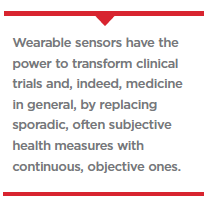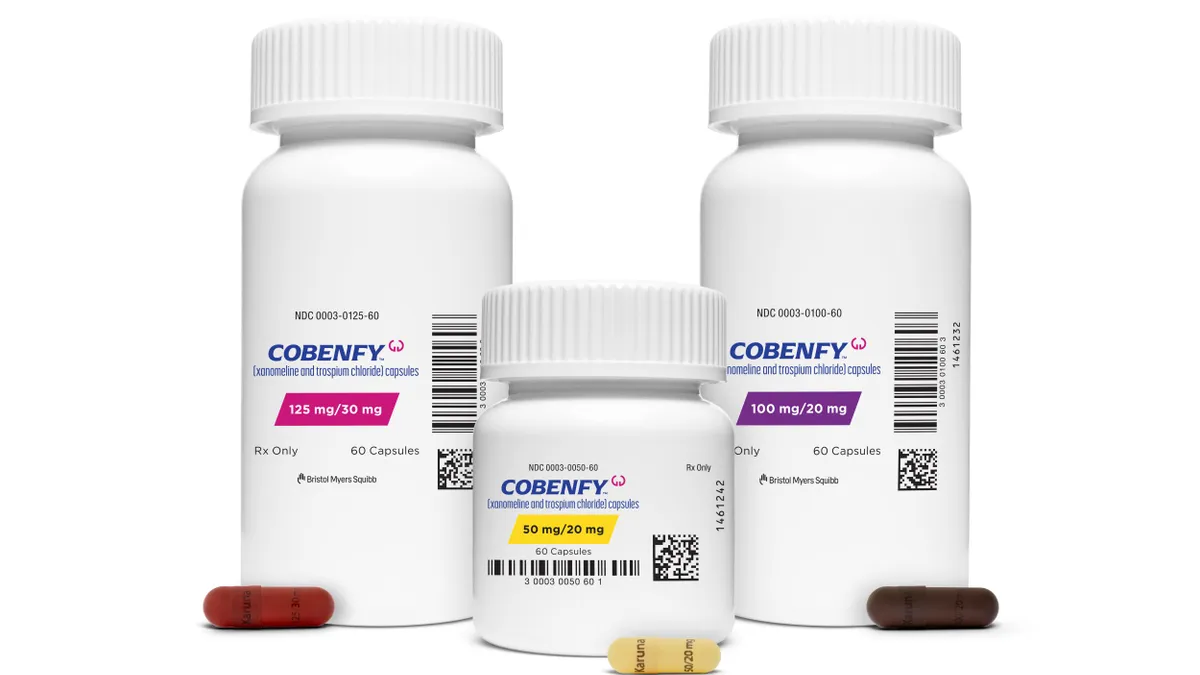 Wearable sensors have the power to transform clinical trials and, indeed, medicine in general, by replacing sporadic, often subjective health measures with continuous, objective ones. Instead of doctors asking their patients during occasional visits whether they have been sleeping well or been active, wearables can answer precisely how much they have been sleeping, how active they have been, how these parameters are changing over time, how consistent they are, and many other questions that provide a much richer and more accurate view of patient health.
Wearable sensors have the power to transform clinical trials and, indeed, medicine in general, by replacing sporadic, often subjective health measures with continuous, objective ones. Instead of doctors asking their patients during occasional visits whether they have been sleeping well or been active, wearables can answer precisely how much they have been sleeping, how active they have been, how these parameters are changing over time, how consistent they are, and many other questions that provide a much richer and more accurate view of patient health.
Capturing more accurate, quantitative health measures provide the opportunity to improve the accuracy of early-stage trials, leading to fewer later-stage failures. It also enables a significant reduction in the number of participants required for those trials. All of this can be done remotely and continuously, reducing clinic visits, and improving safety.
Despite this potential, the adoption of wearables in clinical trials is still the exception rather than the rule. The primary obstacle is lack of accepted clinical endpoints — the outcome measures that determine whether the trial is successful — for wearables. The Digital Medicine Society’s (DiMe’s) Library of Digital Endpoints identifies only 38 studies that used digital technology for primary endpoints and another 32 that used it for secondary endpoints out of the tens of thousands of trials conducted during that period.1 Unless wearables provide clinical endpoints, they do not affect the trial result and provide no direct value to the trial itself.
It takes significant effort to qualify a wearable clinical endpoint (see the V3 framework2). It requires verification of the sensor’s accuracy, analytical validation that the algorithm used measures the physiological metric desired, and clinical validation that the physiological metric is meaningful from a clinical perspective. The challenge is that these steps need to be performed for every wearable sensor, every algorithm, and every population of interest.
 This would be an overwhelming problem, except that the validation process can be broken into semi-independent steps. Sensor verification should not need to be repeated for every algorithm, so long as the sensor provides the correct data.
This would be an overwhelming problem, except that the validation process can be broken into semi-independent steps. Sensor verification should not need to be repeated for every algorithm, so long as the sensor provides the correct data.
Analytical validation of an algorithm should not need to be repeated for every sensor, so long as it has been verified to produce the right data. So long as an algorithm has been validated to produce the correct physiological metric, clinical validation should not need to be repeated.
But to realize these benefits, the industry will need to collaborate.
Share Data
Sharing data is perhaps the most important contribution that the industry can make to help realize wearables’ full potential. Data collection is the most time consuming and expensive part of the whole validation process. With access to appropriate datasets, data scientists can develop and validate algorithms in just weeks or months. But it needs to be essentially raw data with little preprocessing because the preprocessing itself is part of the algorithm. Verifying a sensor against raw data is straightforward and should be done by each manufacturer.
Share Algorithms
Every algorithm needs to have analytical validation. But if every sensor manufacturer has its own proprietary algorithms, each sensor will need to go through this process. However, there is a growing movement toward the adoption of open-sourced wearable algorithms. Pfizer and others have made their algorithms open source. The Open Wearables Initiative (www.owear.org) is dedicated to promoting and cataloging wearable algorithms and data. An open-source algorithm needs to be validated only once and then it can be used by anyone.
Coordinate and Support
One of the most challenging areas is clinical validation because of the sheer number of conditions, symptoms, and patient populations that need to be studied. By coordinating with other companies that share similar therapeutic interests, and ideally consolidating the number of clinical endpoints to those that are measuring truly independent physiological metrics, this challenge can be reduced to manageable levels.
Of course, coordinating and performing these clinical validation studies requires effort and money. There are multiple non-profit organizations that could provide the effort and coordination, but funding will need to come from sponsors.
By working together, we can use wearables to transform clinical trials.(PV)
Notes:
1 DiMe’s Library of Digital Endpoints. https://www.dimesociety.org/communication-education/library-of-digital-endpoints
2 Goldsack, et al, “Verification, Analytical Validation, and Clinical Validation (V3): The Foundation of Determining Fit-for-purpose for Biometric Monitoring Technologies (BioMeTs)," NPJ Digital Medicine (2020) 55, Scripps Research Translational Institute.
Shimmer Research, with customers in more than 75 countries, is a leading wearable technologies company based in Dublin, Ireland. Shimmer is focused on three business areas: clinical research, neuromarketing, and academic research. Verisense is a flexible, open platform of sensors and software that makes adding wearables to clinical research easy and reliable.
For more information, visit verisense.net.



















